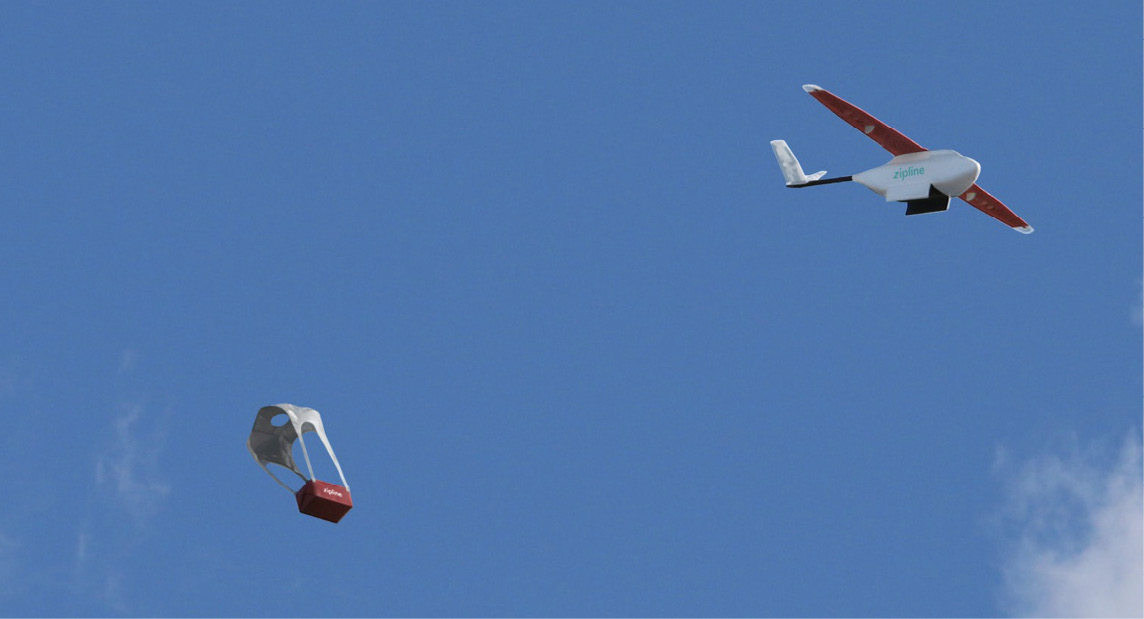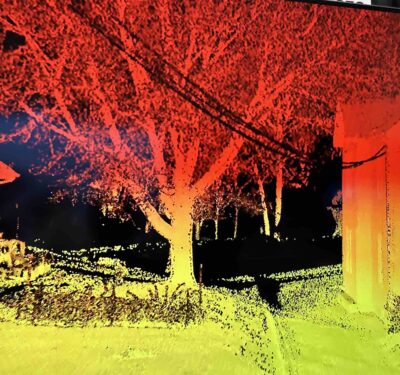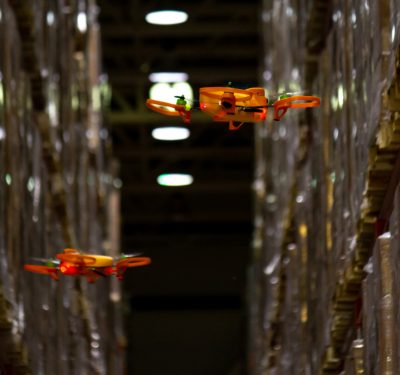
Windhorse Aerospace
Drones can do so much more than take photos and inspect cell phone towers. They can ferry critical supplies to hard-to-reach areas and drop off life-saving packages to disaster survivors.
One company, Zipline International in San Francisco, is deploying unmanned aerial systems (UAS) to drop off lifesaving packages of blood in Rwanda—and is the world’s first national drone delivery service. Another company, Windhorse Aerospace in Wells, England, is developing a UAS intentionally designed for a one-way trip. The aircraft is made of combustible or even edible materials that can be taken apart by disaster survivors after it lands and used for fires or meals.
Zipline noted that more than 2 billion people lack adequate access to vital medical supplies because of challenging terrain and gaps in infrastructure. The company aims to overcome this problem with its fixed-wing, twin-engine UAS, called “Zips,” to fly over potential obstacles such as traffic jams, muddy roads and collapsed bridges and deliver medical supplies via parachutes to hospitals and clinics in Rwanda.
“Everything we do revolves around delivering medical products from where the paved roads end in these countries to where people need them,” said Keenan Wyrobek, co-founder and head of product and engineering at Zipline.
Time is often of the essence with such deliveries. Not only do medical supplies such as blood quickly expire without refrigeration but the difference between a patient living and dying can be a matter of hours.
“Everything we do, everything we build, is geared toward the mission of helping to save lives,” Zipline spokesperson Justin Hamilton said. “The sense of mission is palpable, and motivates everybody.”
Both Wyrobek and Zipline co-founder Keller Rinaudo have backgrounds not just in robotics, but also in health, biology and wellness. “Keenan was one of the founders of Willow Garage, which helped develop the open-source Robot Operating System ROS, and prior to that, he built medical robotic devices for surgery, while Keller made robots on the consumer end, and also built computers out of DNA,” Hamilton said.
Zipline has received $41 million in equity funding in eight rounds from 20 investors, including $25 million in November, according to startup database Crunchbase. Zipline has also received a $1.1 million grant from the UPS Foundation. “We provide them data so they can learn about drone delivery, and they provide mentorship on how to deliver packages on time,” Wyrobek said.
Setting Up Base
After consulting with four countries around the world, Zipline opened up a base in Rwanda in October to serve the western half of that nation with 15 Zips.
“The reason that Rwanda is first is because it’s very data-focused in its decision-making processes,” Wyrobek said. “It’s focused on how investments made using data can improve its health system and save money.”
Zipline’s distribution center safely stores blood and blood products such as plasma and platelets collected by the Rwandan national blood banks. So far this base services 11 clinics, and Zipline aims to serve a total of 21 by the end of the year, Hamilton said.
“Scaling up service to each clinic requires intensive preparation,” Hamilton said. “We have to map out routes, coordinate with civil and military aviation authorities so they’ll know the exact routes they’ll fly in each and every instance, and know places for the planes to maintain holding patterns if necessary. We also have to train hospital staff on what to do when robots start dropping packages from the sky, since it’s not something that happens everyday. We also want to work with people in the community—in many parts of the world, when drones fly overhead, they don’t bring good tidings—so we want to work with communities so they’ll know our planes are the equivalent of sky ambulances out to save someone’s life.”
Parachuting Supplies
To get medical supplies, health workers at remote clinics and hospitals text an order to Zipline. Zipline’s distribution center then packages what they’ve requested in paper insulation to help it stay the right temperature during flight.
A fully automated preflight test of the Zip’s propulsion, control surfaces, communications equipment and other features ensure the drone is airworthy. The medical supplies and a new lithium-ion battery pack are then loaded onboard the 14-kilogram Zip.
A catapult helps launch the Zip into the air and the health workers at the clinic or hospital receive confirmation their order is on the way. The Zip flies at speeds of up to 100 km/h, reaching its destination in 30 minutes on average, Hamilton said. “We have spectators almost every day, where people cheer the launches and the landings,” Wyrobek said.
An advanced autopilot and GPS navigation help the Zip keep to a predetermined route. A Zipline controller at the base monitors the drone’s progress and stays in radio contact with Rwandan civil and military aviation authorities in case the Zip needs to change course or hold position.
On a full charge, a Zip can make a 150-kilometer round-trip, carrying about 1.5 kilograms per flight. They can operate 24-7 in all weather. “What’s really typical is that operators will think it’s a beautiful day, all of our weather data sources in the area think that there is no rain, and the plane will come back soaking,” Wyrobek said.
When the Zip is five minutes away from its destination, the health workers will get a text message letting them know they will soon receive their package. The Zip then gently drops off the supplies via a paper parachute onto a designated area the size of a few parking spaces.

Zipline
Finally, the Zip returns to base, where it uses a tailhook to catch onto a cable on the ground and then land onto an inflated mat. “We call this ‘aircraft carrier meets bouncy castle,’” Wyrobek said. “Rough landings are bad for the lives of planes.”
The cable that catches the Zip’s tailhook is mounted on two adjustable robotic arms that move to help catch the plane as it lands. “We discovered that when the wire could move, it reduced the need for unsuccessful landing attempts,” Hamilton said.
Each Zip has redundant electric motors, batteries, GPS and other electronics, as well as an emergency parachute landing system. This is because the Zips are not flying “in the middle of nowhere,” Wyrobek said. “These are pretty populated areas. They’re not urban, but there’s a lot of people there, especially around the delivery sites.”
Delivering medical supplies quickly when health workers need them “lets less medical supplies go to waste,” Hamilton said. “A huge amount of medicine spoils because it doesn’t get used. Instead of people guesstimating and projecting what they might need, in-time delivery helps people get what they need when they need it. It’s a more-efficient use of these supplies, and brings down costs.”
One hiccup that Zipline experienced involved their planes getting stuck in customs in Addis Ababa during a state of emergency in Ethiopia, Hamilton recalled. When Zipline finally got the UAS and put one in the air, “it needed to make an emergency landing,” he said. “We realized what happened was that some of the bonding and components got affected during shipping. We often outsourced small things at the time, and our solution was to in-source them, to build them ourselves.”
Zipline’s Plans
Zipline’s first base currently makes deliveries every day. “Sometimes we have up to 50 flights a day,” Hamilton said.
Within the next year, Zipline aims to open a second base in Rwanda to serve the eastern half of the country. “All of Rwanda’s 11 million citizens will be within reach of our on-demand, life-saving medical services,” Hamilton said.
Quick aerial delivery of blood could help people far beyond Rwanda. For instance, when it comes to postpartum hemorrhaging—potentially lethal blood loss after childbirth—“the United States leads the industrialized world in postpartum hemorrhaging deaths,” Hamilton said. “We’re dealing with a problem across both the developed world and developing world, and Rwanda is helping develop a cutting-edge solution to this problem.”
Currently Zipline’s contract with Rwanda only involves delivery of blood and blood products. “We do plan to expand to offer other critical lifesaving medicines, such as antimalarials, vaccines and AIDS and HIV medications,” Hamilton said.
Zipline has also explored developing a mobile distribution center “that could be shipped out in two cargo containers, so a base can be set up very quickly in emergency or humanitarian situations,” Hamilton said. “That’s still something we’re thinking about, but right now our focus is on establishing permanent bases within countries to serve national populations on an ongoing daily basis.”
Meanwhile, “we’re developing a new iteration of the aircraft about every four months,” Hamilton said. “We’re in a constant process of improvement with the batteries and the flight times and speeds.”
One-way UAS
Instead of building unmanned aircraft that airdrop small packages of emergency supplies in round-trip flights, Windhorse seeks to develop the Pouncer UAS, which delivers large amounts of such necessities with one-way journeys. “As far as we know, we are building the first intentionally one-way drone,” said Rob Forrester, business development manager at Windhorse. “By not worrying about whether the drone will fly back, we can effectively double the distance it can travel.”
The idea for the Pouncer came when Windhorse founder Nigel Gifford and his colleagues were looking for a new project to undertake. In 2014, they sold their Ascenta project to Facebook for roughly $20 million. The aim of that solar-powered UAS, now renamed Aquila, is to stay at high altitudes for weeks to months at a time to supply wireless Internet access for those in remote areas.
Although Gifford’s background included aeronautical engineering, he was also trained as a chef by his restaurateur father and had worked for years in the British Army Catering Corps. These experiences combined for his latest project, which not only could deliver food, but could even one day be partly made of food.
The notion for the Pouncer came from a conversation Gifford had with a Royal Air Force officer who sought tips on how to get humanitarian aid into war zones. Trucks are susceptible to mines, helicopters are vulnerable to attack, and parachuted supplies are inaccurate, with such pallet drops at times landing in the hands of the enemy.
Gifford suggested that a one-way UAS could deliver supplies to disaster or conflict zones that are otherwise inaccessible or unsafe for humanitarian missions to reach. The disposable airframe could initially be made of wood that people could use for shelter or burn for warmth or cooking. Gifford then reasoned that a one-way UAV could not only carry food, but could itself be made partly from edible materials, such as uncooked pasta, if they had light and strong laminated or honeycomb structures.
Prototypes This Year
The first Pouncer UAS will be made of traditional construction materials, such as wood and plastic, to ensure quicker certification. Once tested and deployed, Windhorse then will concentrate on replacing as much of the fuselage, skin, core, struts, wing and winglets as possible with edible materials. Although this idea may seem pie-in-the-sky, “if we can get an extra 5 kilograms of food onto a drone by using edible materials as structural materials, this strategy means we can feed an extra five people for a day,” Forrester said.
Windhorse currently envisions three different sizes of the delta wing Pouncer UAS. The 1.8-meter-wingspan Mark I will weigh about 25 kilograms when fully loaded and will be able to carry about 20 kilograms of supplies—enough to keep 20 people alive for 24 hours. The 2.8-meter-wingspan Mark II will weigh 60 kilograms when fully loaded with 50 kilograms of cargo for 50 people, while the 3.8-meter-wingspan Mark III is expected to top out at around 120 kilograms when fully loaded with 100 kilograms of supplies for up to 100 people for a 24-hour period, Forrester said. “We’re going to introduce the Mark II first,” Forrester said.
Initial tests with Pouncer UAS involved a small electric motor and batteries that could provide up to 20 minutes of climb time. They will ultimately rely on simple off-the-shelf GPS for guidance, and an autopilot functionality chip for control, Forrester added. “I call it a van with wings,” he said.
A Pouncer could get launched a number of different ways—from the back of a transport plane, from a weather balloon, from a ship, or from a catapult on the ground. The motor can then help it climb in altitude, and the UAS will glide the rest of the way to the target. Depending on the altitude the Pouncer can reach, it could travel up to 100 miles, Forrester said. “That way a transport aircraft may not necessarily have to fly over hostile territory,” he said.
To land, a Pouncer would slow and then stall its flight, deploying a parachute or some other device to help it gradually descend from a height of about 300 or 400 feet. The firm believes it can land a Pouncer within seven to 10 meters of a particular point, Forrester said. Windhorse would work with emergency services and other organizations to designate landing zones.
Windhorse is currently testing concept demonstrators and is looking to build several full prototypes over the summer. The company is aiming for full flight tests before the end of 2017, with Pouncers ready for certification in early 2018 if all goes well, Forrester said.
“We will initially be launching Mark-II glider variants without the motor, which can be operated from transport aircraft in large volumes to help large-scale operations,” Forrester said.






